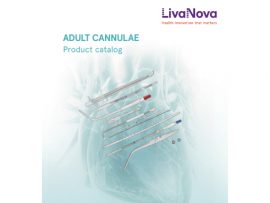Abstract Introduction Extracorporeal membrane oxygenation (ECMO) is utilized in critically ill neonates with severe cardiopulmonary failure. Hemolysis is a potential complication and is associated with significantly increased morbidity and mortality...
Read MoreAbstract Objectives Acute kidney injury (AKI) is a common and serious complication of cardiac surgery, often linked to the use and duration of cardiopulmonary bypass (CPB). The Hemolysis Index (HI)..
Read MoreAbstract Introduction: In cardiopulmonary bypass (CPB), blood circulation is temporarily maintained by an artificial blood-pumping device during cardiac surgery. Worldwide, approximately half of the CPB procedures utilize either centrifugal or..
Read MoreAbstract Venopulmonary arterial (VPA) extracorporeal membrane oxygenation (ECMO) is emerging as an alternative to traditional venovenous (VV) ECMO for respiratory failure. This study compares rates of hemolysis and acute kidney..
Read MoreAbstract Extracorporeal circulation (ECC) procedures, including extracorporeal membrane oxygenation (ECMO), provide essential support for critically ill patients, but complications such as hemolysis and thromboembolic events remain significant concerns. This study..
Read MoreAbstract Objective Hemolysis is a complication in surgical procedures requiring cardiopulmonary bypass (CPB). The primary aim of this study was to evaluate the effectiveness of the point-of-care device Hemcheck Helge..
Read MoreAbstract BACKGROUND: Critically ill patients who receive circulatory or respiratory assist using extracorporeal membrane oxygenation (ECMO) may develop hemolysis, which can complicate the delivery of supportive care and be a..
Read MoreAbstract Background Hemolysis is a common complication in critically ill patients with sepsis, acute respiratory distress syndrome (ARDS) or therapy with extracorporeal membrane oxygenation (ECMO). Heme degradation product bilirubin might..
Read MoreAbstract Introduction: Hemolysis, characterized by increased carboxyhemoglobin (COHb) and methemoglobin (MetHb) levels, is a complication of extracorporeal membrane oxygenation (ECMO). Methods: This prospective single-center study aimed to investigate the correlation..
Read MoreAbstract Background Hemolysis, variably defined in mechanical circulatory support (MCS), is understudied in percutaneous left ventricular assist devices. We characterize hemolytic sequelae of Impella 5.5-supported patients in the largest series..
Read MoreAbstract Hemolysis induces tissue damage by releasing cellular contents into the plasma. It is widely accepted that hemolysis-derived toxic molecules are cleared by macrophages or metabolized in hepatocytes. In zebrafish,..
Read MoreAbstract Haemolysis occurring during cardiac surgery with cardiopulmonary bypass (CPB) is assumed to be a risk factor for postoperative acute kidney injury (AKI). Plasma alpha-1 microglobulin (A1M) may have a..
Read MoreAbstract Hemolysis-induced acute kidney injury (AKI) is attributed to heme-mediated proximal tubule epithelial cell (PTEC) injury and tubular cast formation due to intratubular protein condensation. Megalin is a multiligand endocytic..
Read MoreAbstract Introduction Exogenous haptoglobin administration may enhance plasma-free hemoglobin (pfHb) clearance during hemolysis, and reduce its end-organ damage: we sought to systematically review and summarize available evidence on the use..
Read MoreAbstract Cell-free hemoglobin (CFH) is used to detect hemolysis and was recently suggested to trigger acute lung injury. However, its role has not been elucidated in severe acute respiratory distress..
Read MorePresented by: Timothy M. Maul, CCP, FPP, PhD The Hoosier Extracorporeal Science Conference (HESC) is hosted and managed by Heartbeat Perfusion Solutions Inc. The video content has been made available..
Read MoreAbstract Background: Hemolysis is a frequent complication in patients with sepsis, ARDS, or extracorporeal membrane oxygenation (ECMO). Haptoglobin (Hp) can scavenge released cell-free hemoglobin (CFH). Hemolysis and low plasma concentrations of..
Read MoreAbstract Purpose: Red-colored urine often occurs in patients in the perioperative period who undergo cardiac surgery using cardiopulmonary bypass (CPB). This urine color change has been utilized for approximating hemolysis..
Read MoreAbstract To investigate the effects of blood pumps operated in different modes on nonphysiologic flow patterns, cell and protein function, and the risk of bleeding, thrombosis, and hemolysis, an extracorporeal..
Read MoreAbstract Background The use of cardiopulmonary bypass (CPB) is almost inevitable in cardiac surgery. However, it can cause complications, including hemolysis. Until now, there have not been any standards for..
Read MoreAbstract The aim of this study was to explore the association between arterial return cannula diameter and hemolysis during peripheral VA ECMO. We identified 158 adult patients who received peripheral..
Read MoreAbstract Ex vivo hemocompatibility testing is a vital element of preclinical assessment for blood-contacting medical devices. Current approaches are resource intensive; thus, we investigated the feasibility of accelerating hemocompatibility testing by standardizing..
Read MoreAbstract Extracorporeal membrane oxygenation is a life-saving support therapy in the case of cardiopulmonary refractory failure. Its use is associated to complications due to the presence of artificial surfaces and..
Read MoreAbstract Extracorporeal circulation (ECC) procedures, such as cardiopulmonary bypass (CPB) and extracorporeal membrane oxygenation (ECMO), take over the function of one or more organs, providing clinicians time to treat underlying pathophysiological..
Read MoreAbstract Hemolysis usually happens instantly when red blood cells (RBCs) rupture under a high shear stress. However, it is also found to happen gradually in the extracorporeal membrane oxygenation (ECMO)..
Read MoreAbstract The Acute Respiratory Distress Syndrome (ARDS) is common in patients on the Intensive Care Unit and associated with significant mortality rates. In situations of severe respiratory insufficiency and failure..
Read MoreAbstract Objective: To describe factors associated with hemolysis during pediatric extracorporeal membrane oxygenation (ECMO), and the relationships between hemolysis, complications and mortality. Design: Secondary analysis of data collected prospectively by..
Read MoreAbstract In vitro testing of hemolysis is essential for the validation and development of ventricular assist devices. However, as many factors influence hemolysis, such tests’ inter- and intralaboratory reproducibility is poor...
Read MoreAbstract OBJECTIVES: To determine potential risk factors for severe hemolysis during pediatric cardiopulmonary bypass and examine whether supraphysiologic levels of oxygen and cardiopulmonary bypass duration are associated with hemolysis. DESIGN: ..
Read MoreAbstract Introduction Extracorporeal membrane oxygenation (ECMO)–associated hemolysis still represents a serious complication. The present study aimed to investigate those predictive factors, such as flow rates, the use of anticoagulants, and..
Read More














